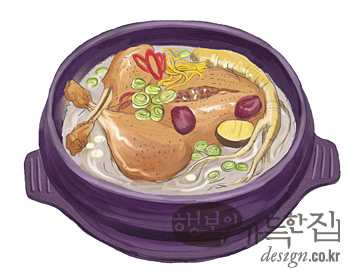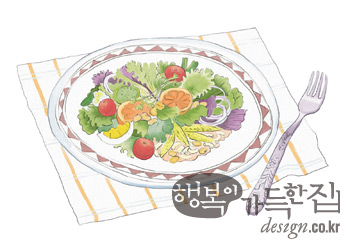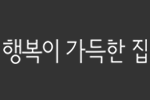 매력적인 여름 샐러드, 여름 햇살 속의 야외 바비큐, 가장자리를 잘라낸 식빵으로 만든 오이 샌드위치…. 한국 사람들은 이런 몇 가지 음식을 전혀 여름철 보양식으로 여기지 않는다. 하지만 유럽에 가면 대륙 전체가 이런 음식을 먹고 있는 것을 발견하게 될 것이다. 한국 사람들 대부분은 땀이 줄줄 흐르는 여름에도 이런 음식 대신 삼계탕이나 추어탕, 닭칼국수 같은 뜨거운 탕 그릇에 숟가락을 들이밀고, 일부는 보신탕에까지 손을 뻗친다. 서양인에게는 더운 날 뜨겁고 가끔은 맵기까지 한 국물 음식을 먹는다는 발상 자체가 완전히 4차원적이다. 한국에서의 첫 여름, 나는 레스토랑 메뉴들이 더욱 ‘시원하고’ 좀 더 ‘신선한’ 음식으로 바뀌길 기대했지만 놀랍게도 35℃를 웃도는 날씨에도 한국 사람들은 여전히 펄펄 끓는 음식을 즐기고 있었다. 얼마간 나는 집에서 샐러드를 만들고, 사람들에게 인기 있는 찬 음식인 콩국수와 메밀국수 두 가지에 매달리며, 여름에 뜨거운 음식을 즐기는 한국의 트렌드를 거부하려고 애썼다. 하지만 시간이 지나면서 고군분투하는 것은 나 혼자뿐이고, 한국 사람들은 여전히 ‘어떤 근거’에 의해 뜨거운 음식을 즐기고 있으며, 이젠 나도 거기에 동참할 때라는 것을 깨달았다.
매력적인 여름 샐러드, 여름 햇살 속의 야외 바비큐, 가장자리를 잘라낸 식빵으로 만든 오이 샌드위치…. 한국 사람들은 이런 몇 가지 음식을 전혀 여름철 보양식으로 여기지 않는다. 하지만 유럽에 가면 대륙 전체가 이런 음식을 먹고 있는 것을 발견하게 될 것이다. 한국 사람들 대부분은 땀이 줄줄 흐르는 여름에도 이런 음식 대신 삼계탕이나 추어탕, 닭칼국수 같은 뜨거운 탕 그릇에 숟가락을 들이밀고, 일부는 보신탕에까지 손을 뻗친다. 서양인에게는 더운 날 뜨겁고 가끔은 맵기까지 한 국물 음식을 먹는다는 발상 자체가 완전히 4차원적이다. 한국에서의 첫 여름, 나는 레스토랑 메뉴들이 더욱 ‘시원하고’ 좀 더 ‘신선한’ 음식으로 바뀌길 기대했지만 놀랍게도 35℃를 웃도는 날씨에도 한국 사람들은 여전히 펄펄 끓는 음식을 즐기고 있었다. 얼마간 나는 집에서 샐러드를 만들고, 사람들에게 인기 있는 찬 음식인 콩국수와 메밀국수 두 가지에 매달리며, 여름에 뜨거운 음식을 즐기는 한국의 트렌드를 거부하려고 애썼다. 하지만 시간이 지나면서 고군분투하는 것은 나 혼자뿐이고, 한국 사람들은 여전히 ‘어떤 근거’에 의해 뜨거운 음식을 즐기고 있으며, 이젠 나도 거기에 동참할 때라는 것을 깨달았다. 물론 유럽과 한국의 음식이 이렇게 극단적으로 다른 데는 많은 이유가 있다. 그중 재료의 차이가 한 가지 이유겠지만, 또 한 가지는 기후의 차이다. 유럽과 한국은 둘 다 북반구에 있으며 한국은 영국이나 독일과 위도상으로 비슷한 위치에 있다. 하지만 한국의 여름은 대부분의 유럽 지역보다 훨씬 습하다. 유럽의 여름은 습기가 없고, 조금은 더 맑은 공기가 한국보다는 훨씬 빨리 저녁 공기를 식혀준다. 한국의 여름 공기는 종종 찌는 듯이 덥고 습기가 가득해 숨쉬기조차 어려워 많은 사람이 피곤해하고 늘어진다. 그러나 유럽에서는 특히 영국 같은 나라에서는 건조한 공기가 사람들에게는 더욱 활기를 준다. 런던에서는 덥고 햇볕 쨍쨍한 날이면 대부분의 사람들이 도시락을 싸서 공원을 찾거나 마당에서 바비큐를 즐긴다. 길거리엔 모처럼 좋은 날씨를 즐기는 사람들로 가득하다. 하지만 한국의 6~7월은 태풍 철이어서 에너지를 뺏기며 대다수 사람들의 기분이 처진다. 이런 상황에서 한국인은 단백질과 영양가가 많은 뿌리 식품을 섭취해야 에너지가 보충된다고 믿는다.
삼계탕은 아마도 여름철 한국 음식의 제왕일 것이다. 인삼과 생강, 마늘, 찹쌀과 대추로 속을 채운 닭 한 마리는 한국인이 강장제로 여기는 모든 것의 집합체다. 탄수화물과 단백질, 수분 함량이 높으며 점심에 먹으면 남은 고된 하루를 버텨낼 기운을 북돋우는 데 이상적이다. 그러나 이럴 때 먹는 서양 음식은 거의 정반대다. 양상추와 토마토, 스위트 콘과 로켓 rocket(유럽에서 즐기는 쌉쌀한 맛이 도는 겨자과의 샐러드 채소) 같은 제철 채소가 샐러드 재료로 주로 쓰이는데, 모두 섬유소는 많고 탄수화물은 적은 것들이다.
이렇게 다른 두 가지 음식은 이 계절에 두 가지 다른 양상을 보이는 사람들의 라이프스타일을 고스란히 반영한다. 서울처럼 뜨겁고 땀이 흐르는 도시에서는 사람들이 여름의 열기를 피하려고 최선을 다하며, 여가 시간에는 집에서 선풍기를 틀어놓고 마루에 누워 지낸다. 그러나 같은 시기에 유럽의 열기는 한국보다 덜 가혹해서, 서양인은 긴 겨울 동안에만 집에서 소파에 누워 텔레비전을 보며 지낼 뿐이다. 여름철, 정원이 딸린 집에 사는 사람들은 바깥에서 식사를 즐기고, 특히 시골에서는 각양각색의 여름 카니발과 축제가 열려 사람들을 끌어들이며, 도시는 관광객과 쇼핑객들로 북적인다.
이런 이유로 여름철 서양인에게 무겁고 뜨거운 음식은 그리 매력적이 아니다. 그들은 기름진 음식으로 위에 부담을 주기보다 다양한 프로그램으로 가득 찬 긴 활동 기간을 즐길 수 있게 해주는 가벼운 음식을 선호한다. 그러나 같은 기간, 매력적인 여름 샐러드가 7~8월의 한국 식탁에 자리를 잡긴 어려울 것이다. 삼계탕을 먹은 다음 몇 시간이 지나면 생기가 돌고 나머지 하루를 보내는 데 필요한 스태미나가 생기니까 말이다. 한국에서 서양 음식이 인기를 끌고 있지만, 한국의 여름철 식생활이 그리 급작스럽게 바뀔 것 같지는 않다. 아마 앞으로 한국의 여름 식탁에 몇 가지 샐러드와 샌드위치가 등장할지는 모르지만, 한국인이 여름철에 먹어야 한다고 믿는 근본적인 지혜의 빛이 바래지는 않을 것이다. 그러니 보신탕과 추어탕 집 주인들은 아직 생계 걱정을 할 필요는 없을 것이다. 집 밖의 맹렬한 열기에도 불구하고, 한국인은 세대에 걸쳐 아직도 여름에 뜨거운 국물을 먹으며 ‘시원하다’고 하니까 말이다.
food essay
Sexy summer salads, barbecues outside in the summer sunshine, cucumber sandwiches with the crusts cut off. These are just a few of the things that Koreans will not even be contemplating eating this summer. But hop on a plane to Europe, and you will discover an entire continent eating things like this. Instead of the above, in those sweaty summer months, most Koreans will be digging into steaming hot bowls of samgetang, chuatang, chicken kalguksu, and some will even be reaching for the bosintang. For Westerners, the mere idea of eating hot, often spicy, stews on a hot day is completely alien. In my own first summer in Korea, I was shocked, I kept expecting restaurant menus to change to include “colder”, more “refreshing” dishes, but to my surprise, even in temperatures of 35 degrees and upwards, Koreans were still eating food that is mostly served bubbling hot. For a while, I tried to fight against this Korean trend of eating hot food in summer - making salads to eat at home, and sticking to kong guksu and memil guksu - the only two truly popular cold dishes - when out and about. But, after a while, I realized that I was alone in my struggle, that Koreans were obviously eating what they were still eating for a reason, and it was time for me to join them. Of course, there are many reasons why cuisines differ so radically between Europe and Korea. The availability of ingredients is one, but the other is the difference in climate. Summers in Korea are much wetter than they are in most of Europe. There, the heat is dry, and the clearer air allows the evenings to cool down more than they usually do in Korea. Here, the air is often muggy in summer, making it hard to breathe and making many people tired and sluggish. However, in Europe, the dry weather tends to make people more energetic in countries like the UK. In London, a hot, sunny day will be an occasion for most people to head to parks with picnic food, or go out into their gardens to barbecue. But in Korea, June-July s typhoon season saps energy, and leaves most people feeling run down. In such circumstances, Koreans believe in the power of protein and healthy root-based food to give them the extra energy they need.
 Samgetang is, quite possibly, the king of such Korean food. A whole chicken, stuffed with ginseng, ginger, garlic, sticky rice and Korean dates, it is a combination of all the things that Koreans think give you strength. It is high in carbohydrates, protein and water, and is ideal for building up strength for a tiring day ahead if eaten at lunch time. However, Western food eaten at this time is almost the polar opposite. Salads are mostly made of seasonal vegetables like lettuce, tomatoes, sweet corn and rocket, all of which are high in fibre and low in carbohydrates.
Samgetang is, quite possibly, the king of such Korean food. A whole chicken, stuffed with ginseng, ginger, garlic, sticky rice and Korean dates, it is a combination of all the things that Koreans think give you strength. It is high in carbohydrates, protein and water, and is ideal for building up strength for a tiring day ahead if eaten at lunch time. However, Western food eaten at this time is almost the polar opposite. Salads are mostly made of seasonal vegetables like lettuce, tomatoes, sweet corn and rocket, all of which are high in fibre and low in carbohydrates.The principles behind the two different kinds of food reflect the lifestyles lead by these two different sets of people around this time. In hot, sweaty cities like Seoul, people do their best to stay out of the summer heat, and in their free time, stay at home, lying on the floor with a fan on. But in Europe at this time, the heat is less oppressive, and Westerners, who have spent the long winter days lying at home on their sofas watching television. Most people with gardens will eat outside, there are all sorts of summer carnivals and festivals, which draw great crowds of people.
For this reason, heavy, hot food is unattractive to Westerners in summer - they do not want their stomachs laden down with stodgy food, they prefer to eat light food that allows them to stay active enough to be able to engage in a long program of varied activities. But the sexy summer salad has no real place in the Korean diet come July and August. A few hours after a good dish of samgetang, you can feel revived and full of the stamina you need to see you through the rest of the day. Even as Western food gains popularity in Korea, it is unlikely that the Korean summer diet will ever radically change. We may see a few more salads and sandwiches become available in summers to come in Korea, but the basic wisdom that inspires Koreans to eat what they eat in summer is unlikely to vanish. Bosintang and chuatang restaurant owners need not fear for their livelihoods just yet - generations of Koreans still find hot stews “siwonhey” in summer, refreshing, despite the raging summer heat outside their doors.
*글을 쓴 팀 알퍼 씨는 한국 거주 3년 차인 32세의 영국인으로 현재 국내 라디오 영어 방송인 TBS eFM의 프로듀서입니다. 한국을 좋아하고 한국 문화, 특히 음식에 관심이 많은 이 벽안의 남자는 어머니가 프랑스인이고 스페인, 러시아 등에 거주한 적도 있어 유럽 문화를 다양하게 경험하는 행운을 누렸습니다. 그런 그가 이번 호부터 한국 음식과 서양 음식을 그만의 색다르고 날카로운 관점으로 비교합니다.







